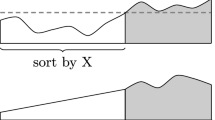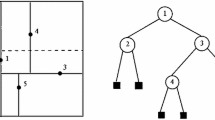Abstract
It is well known that, for fixedk, to find thek-th largest ofn elementsn+(k−1)log2 n+Θ(1) comparisons are necessary and sufficient. But do the same bounds apply if we use a different type of query? We show that the arity of the queries is relevant. In particular, we present upper and lower bounds for finding the maximum using 3-ary or 4-ary Boolean (YES/NO answers) queries. We also study general (e.g.,max, sort) 3-ary queries, and show bounds for finding the maximum and the second largest. For sort queries we show matching upper and lower bounds.
Similar content being viewed by others
References
F. Fussenegger andH. N. Gabow, A Counting Approach to Lower Bounds for Selection Problems,J. Assoc. Comput. Mach. 26 (1979), 227–238.
W. I. Gasarch, On Selecting thek Largest with Restricted Quadratic Queries,Information Proc. Letters 38 (1991), 193–195.
J. W. John, A New Lower Bound for the Set-Partitioning Problem,SIAM J. Computing 17 (1988), 640–647.
D. E. Knuth,The Art of Computer Programming, vol. 3-Sorting and Searching, Addison Wesley, 1973.
S. Moran, M. Snir, andU. Manber, Applications of Ramsey's Theorem to Decision Tree Complexity,J. Assoc. Comput. Mach. 32 (1985), 938–949.
V. Pratt andF. F. Yao, On Lower Bounds for Computing thei-th Largest Element, inProc. 14th IEEE Symp. on Switching and Automata Theory (1973), 70–81.
M. O. Rabin, Proving Simultaneous Positivity of Linear Forms,J. of Computer and System Sciences 6 (1972), 639–650.
M. Nnir, Comparisons Between Linear Functions Can Help,Theoretical Computer Science 19 (1982), 321–330.
A. C. Yao, On the Complexity of Comparison Problems Using Linear Functions, inProc. IEEE 16th Symp. on Foundations of Computer Science (1975), 85–89.
A. C. Yao, On Selecting thek Largest with Restricted Quadratic Queries,Algorithmica 4 (1989), 293–300.
Author information
Authors and Affiliations
Rights and permissions
About this article
Cite this article
Guimarães, K.S., Gasarch, W.I. & Purtilo, J. Selection problems viaM-ary queries. Comput Complexity 2, 256–276 (1992). https://doi.org/10.1007/BF01272077
Received:
Issue Date:
DOI: https://doi.org/10.1007/BF01272077




